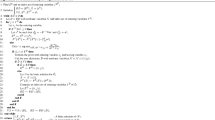Abstract
The first two parts of this paper have developed a simplex algorithm for minimizing convex separable piecewise-linear functions subject to linear constraints. This concluding part argues that a direct piecewiselinear simplex implementation has inherent advantages over an indirect approach that relies on transformation to a linear program. The advantages are shown to be implicit in relationships between the linear and piecewise-linear algorithms, and to be independent of many details of implementation. Two sets of computational results serve to illustarate these arguments; the piecewise-linear simplex algorithm is observed to run 2–6 times faster than a comparable linear algorithm, not including any additional expense that might be incurred in setting up the equivalent linear program. Further support for the practical value of a good piecewise-linear programming algorithm is provided by a survey of many varied applications.
Similar content being viewed by others
References
R.H. Bartels, A.R. Conn and J.W. Sinclair, “Minimization techniques for piecewise differentiable functions—the ll solution to an overdetermined linear system,”SIAM Journal on Numerical Analysis 15 (1978) 224–241.
A. Charnes, W.W. Cooper and R.O. Ferguson, “Optimal estimation of executive compensation by linear programming,”Management Science 1 (1955) 138–151.
A. Charnes and C.E. Lemke, “Minimization of non-linear separable convex functionals,”Naval Research Logistics Quarterly 1 (1954) 301–312.
G.B. Dantzig, “Recent advances in linear programming,”Management Science 2 (1956) 131–144.
G.B. Dantzig, S. Johnson and W. White, “A linear programming approach to the chemical equilibrium problem,”Management Science 5 (1958) 38–43.
R. Fourer, “Notes on ‘semi-linear’ programming,” informal report, Department of Industrial Engineering and Management Sciences, Northwestern University (Evanston, IL, 1981).
R. Fourer, “A simplex algorithm for piecewise-linear programming I: Derivation and proof,”Mathematical Programming 33 (1985) 204–233.
R. Fourer, “A simplex algorithm for piecewise-linear programming II: Finiteness, feasibility and degeneracy,”Mathematical Programming 41 (1988) 281–315.
R. Fourer, “A simplex algorithm for piecewise-linear programming III: Computational analysis and applications,” Technical Report 86-03, Department of Industrial Engineering and Management Sciences, Northwestern University (Evanston, IL, 1986; revised 1988, 1989).
D. Goldfarb and J.K. Reid, “A practicable steepest-edge simplex algorithm,”Mathematical Programming 12 (1977) 361–371.
J.K. Ho, “Optimal design of multi-stage structures: A nested decomposition approach,”Computers & Structures 5 (1975) 249–255.
J.K. Ho, “Relationships among linear formulations of separable convex piecewise linear programs,”Mathematical Programming Study 24 (1985) 126–140.
R.E. Marsten, “The design of the XMP linear programming library,”ACM Transactions on Mathematical Softeware 7 (1981) 481–497.
Author information
Authors and Affiliations
Additional information
This research has been supported in part by the National Science Foundation under grant DMS-8217261.
Rights and permissions
About this article
Cite this article
Fourer, R. A simplex algorithm for piecewise-linear programming III: Computational analysis and applications. Mathematical Programming 53, 213–235 (1992). https://doi.org/10.1007/BF01585703
Received:
Revised:
Issue Date:
DOI: https://doi.org/10.1007/BF01585703




